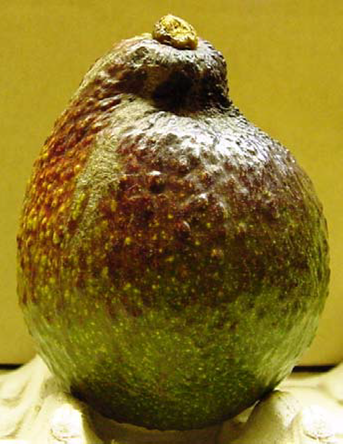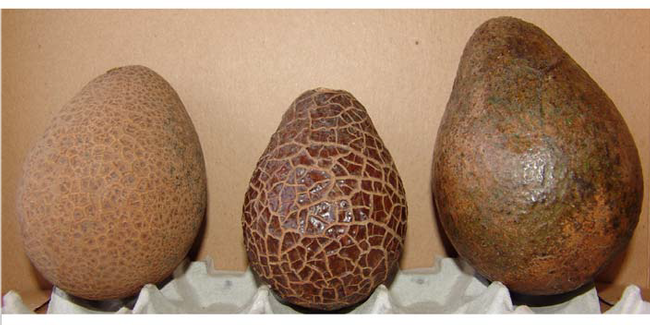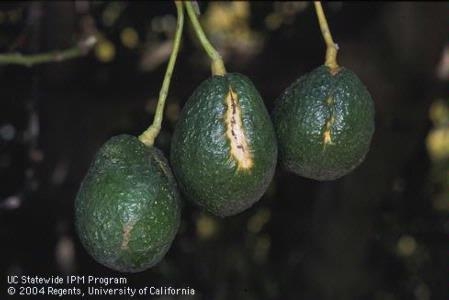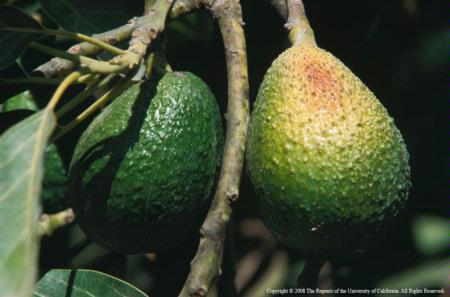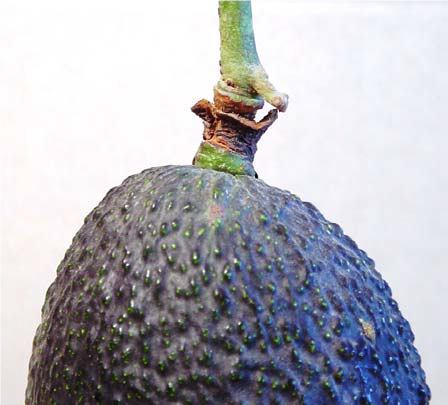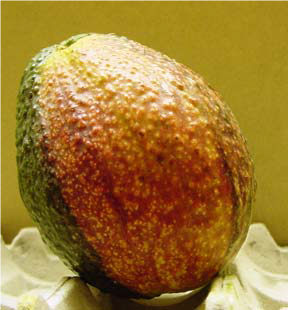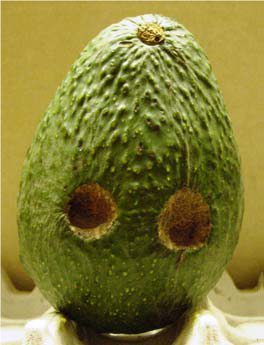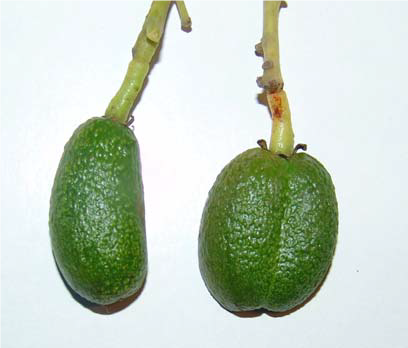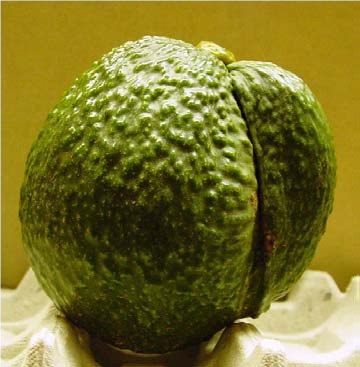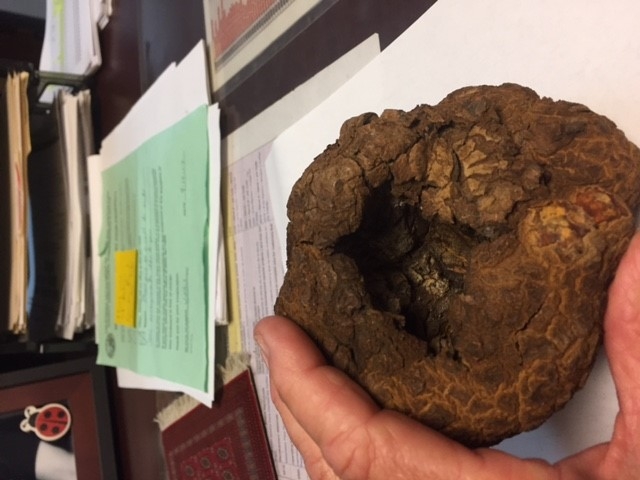- Author: Ben Faber
The latest edition of Topics in Subtropics newsletter is out, Elizabeth Fichtner as editor. Read on.
TOPICS IN THIS ISSUE:
-
Why has California red scale been so difficult to control?
-
Navel Orange Nitrogen Fertilization
-
Recent Advances in Understanding the History of Olive Domestication
- Upcoming UC Olive Center Events

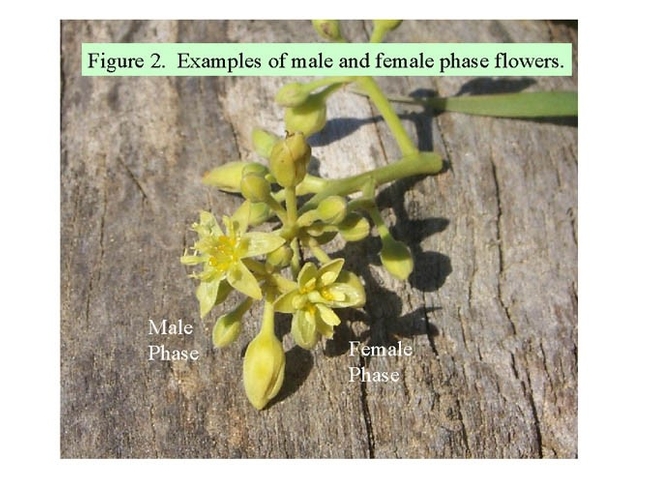
- Author: Frank Byrne, Akif Eskalen and Joe Morse
Two closely related Ambrosia beetles (Euwallacea sp.) have been identified in commercial avocado groves in California. The polyphagous shot hole borer (PSHB), detected in Los Angeles, Orange counties and recently in Ventura county, and the Kuroshio shot hole borer (KSHB), detected in San Diego and recently in Orange and Santa Barbara counties, are morphologically indistinguishable, but genetically distinct. Already widespread in a variety of reproductive host trees common in the urban landscape (including box elder, willow, several maples, oak and sycamore species), the beetles represent a significant threat to trees in both landscape and agricultural settings. Adult females construct galleries in the xylem system of host trees, where they cultivate symbiotic fungi (Fusarium, Paracremonium and Graphium spp.) as a food source for their developing young. The fungi are taken up by progeny females in specialized organs within their mouthparts, and transported to other sites within the same tree, where new colonies are established, or to newly colonized hosts. The galleries compromise the structural integrity of infested trees, which can represent a serious safety hazard in urban environments, and disrupt the flow of water and essential nutrients within the xylem. In addition to the physical damage, the fungi extract nutrients from the xylem system, further depriving the tree of nutrients essential for healthy growth and fruit production.
An effective biological control agent is not yet available to manage the SHB in California, and so management for now must rely on the use of chemical pesticides. The control of Ambrosia beetles and their associated fungi using
chemical pesticides is complicated because of their location inside the host trees. The application of insecticides to the external surfaces of trees, where the beetles must first alight prior to boring, has the potential to kill beetles by contact activity, and they may also have the potential to control emerging young adults before they can re-infest the trees.
The drawback of surface treatments is that multiple applications are often required because of the relatively short duration of efficacy. In addition, once the beetle burrows inside the tree, surface treatments are become ineffective. One possible solution to this problem may be the use of systemic pesticides, and scientists at UC Riverside are evaluating the use of both systemic insecticides and fungicides in a 2-pronged attack against the symbiotic system.
Systemic pesticides are mobile within the xylem system of plants, and the fungicides could potentially target the fungi growing in the xylem and deprive the beetle larvae of a food source. The insecticides would prevent the beetle from establishing galleries within susceptible tree hosts, and prevent the survival of beetles and their offspring already present within trees. The big problem with systemic pesticides is getting sufficient concentrations of chemicals to the areas within the trees where the beetle and fungus occur. Although there are exceptions, most systemic treatments are administered to the soil for uptake through the roots. However, in mature avocado groves, the high organic matter content of the soil can prevent effective absorption by roots because the pesticide becomes bound to organic components within the soil. Trunk injection of pesticides directly into the vascular system of trees eliminates the potential for binding of pesticides within the soil, and increases the amount of active ingredient inside the tree available to impact the beetle/fungal system. Systemic pesticides must be formulated for trunk injection and so careful evaluation is needed to ensure optimal efficacy. Trials are being conducted with the assistance of avocado industry and grower collaborators in areas where the SHB has been recorded. The chemicals are injected into the trees using commercially available equipment, and the movement of the active ingredients is then monitored over time in wood core samples taken at different heights of the trees. Two methods are being used to confirm the presence of the chemicals. Insecticides are being quantified using ELISAs that are specific for the active ingredients under investigation. Wood cores taken from trees treated with fungicides are placed in direct proximity to the fungal pathogens growing on agar plates to determine if growth of the fungus is inhibited.
The investigations are still at an early stage, but the researchers are optimistic that they will develop effective control strategies for the SHB that growers can incorporate into their overall pest management programs. Laboratory based bioassays have been used to identify several pesticides that are toxic to the beetle and fungi. The objective of the field trials is to determine whether these chemicals can be utilized as trunk injection agents for the protection of avocado trees. Anyone interested in finding out more about the SHB should go to the web site maintained by Dr. Akif Eskalen at:
http://eskalenlab.ucr.edu/avocado.html
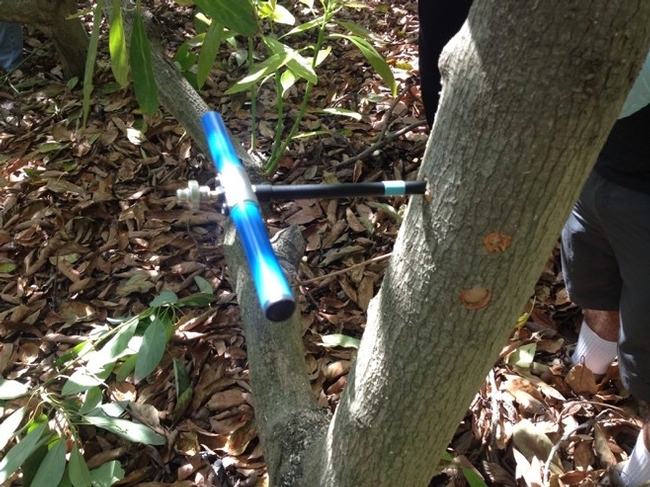
- Author: Elizabeth Fichtner and Rachel Elkins
Lime-induced Iron Chlorosis: a nutritional challenge in the culture of several subtropical perennial crops in California
Elizabeth Fichtner, UCCE Tulare County and Rachel Elkins, UCCE Lake and Mendocino Counties
Spring, and new leaves are coming out, but this could, but yellow could be a sign of iron chlorosis, as well.
Although iron (Fe) is the 4th most abundant element in the lithosphere, Fe deficiency is among the most common plant micronutrient deficiencies. Fe deficiency in plants is common in calcareous soils, waterlogged soils, sandy soils low in total Fe, and in peat and muck soils where organic matter chelates Fe, rendering the element unavailable for plant uptake. In California, lime-induced Fe deficiency is often observed in soils and irrigation water containing free lime, and is exacerbated by conditions that impede soil drainage (ie. compaction, high clay content), resulting in reductive conditions. Given that over 30% of the world's soils are calcareous, lime-induced Fe deficiency is a challenge in numerous perennial cropping systems including: grapes, pears, apple, citrus, avocado, pecans, and stone fruit (prune, almond, apricot, peach, nectarine, cherry).
In most soils, Fe oxides are the common source of Fe for plant nutrition. Solubility of Fe oxides is pH dependant; as pH increases, the free ionic forms of the micronutrient are changed to the hydroxy ions, and finally to the insoluble hydroxides or oxides. In calcareous soils, the bicarbonate ion inhibits mobilization of accumulated Fe from roots to foliage and directly affects availability of Fe in soil by buffering soil pH. When irrigation water is also high in bicarbonate, probability of Fe deficiency is enhanced because bicarbonate is continuously supplied to the soil, and more importantly, the roots may become crusted with lime as water evaporates, thus inhibiting root growth and function. Inside the plant, bicarbonate inhibits nutrient translocation from roots to aboveground plant parts. The adverse effects of high bicarbonate levels are exacerbated in very saturated, very dry, or compact soils, where bicarbonate levels increase concurrent with diminished root growth and nutrient uptake.
Symptoms of Fe deficiency in plants
Fe is immobile in plants; therefore, symptoms appear in young leaves. Interveinal chlorosis (Figure 1) is the main symptom associated with Fe deficiency, followed by reduced shoot and root growth, complete foliar chlorosis, defoliation, shoot dieback, and under severe conditions may result in tree mortality. Overall productivity (yield) is reduced, mainly from a reduced number of fruiting points.
Plant Adaptation
Plant species and cultivars vary in their sensitivity to Fe deficiency, and are categorized as either "Fe-efficient" or "Fe-inefficient". Fe-efficient plants have Fe uptake systems that are switched on under conditions of Fe deficiency. Fe-inefficient plants are unable to respond to Fe deficient conditions. All Fe-efficient plants, except grasses, utilize a Fe-uptake mechanism known as Strategy 1. Strategy 1 plants decrease rhizosphere pH by release of protons, thus increasing Fe solubility. Some plants may excrete organic compounds in the rhizosphere that reduce ferric iron (Fe3+) to the more soluble ferrous (Fe2+) forms or form soluble complexes that maintain Fe in solution. Additionally, roots of Strategy 1 plants have specialized mechanisms for reduction, uptake, and transfer of Fe within the plant. Strategy 2 plants (grasses) produce low molecular weight compounds called phytosiderophores which chelate Fe and take up the chelated Fe with a specific transport system.
Amelioration of Fe chlorosis
Planting sites in calcareous soils should be well drained to provide optimal conditions for root growth and nutrient uptake. Waterlogged and compact soils contain
more carbon dioxide, which reacts with lime to form even more bicarbonate. These conditions, as well as very dry soils, also inhibit microbial activity which aids in
solubilization and chelation of Fe. Prior to planting, soils and water should be tested to determine the pH, lime equivalent, and bicarbonate concentration. Bicarbonate concentrations greater than 3 meq/L in irrigation water increase the hazard of lime accumulation on and around roots. If high bicarbonate water must be used, the pH must be adjusted to 6.0-6.5 to dissolve the bicarbonate and prevent it from negating the effects of soil-based treatments. In microsprinker and drip systems, acidification of irrigation water will also reduce the risk of emitter clogging, a common problem at bicarbonate levels over 2 meq/L. The cost of reducing the pH of irrigation water will more than compensate for the savings incurred from avoiding wasted investment in failed soil- and plant-based remedies. Systems can be set up to continuously and safely inject water with acids such as sulfuric, urea-sulfuric, or phosphoric during irrigations. Specific choice and rate will depend on crop, soil type, other nutrient needs, availability, and cost. Downstream pH meters are available to continuously adjust rate of acid use. Acetic and citric acid can be utilized by organic growers.
Soil based pre-plant treatments to reduce pH include elemental sulfur (S) and acids as mentioned above. It is only necessary to treat a limited area near the root zone to ameliorate symptoms because the tree only needs to take up a small amount of Fe. Material can be shanked in or banded and incorporated in the prospective tree row. One ton of elemental sulfur per treated acre is needed to mitigate three tons of lime, and may need to be re-applied every 3 to 5 years after planting. The addition of organic matter such as well-composted manures will benefit poorly drained or compact soils by increasing aeration for better root growth, fostering chelation of nutrient cations, and reducing pH (depending on source material).
If possible, choose a Fe efficient species or cultivar. In perennial systems, lime-tolerant rootstocks may be the first line of defense in combating Fe deficiency. Some rootstocksmentioned are peach-almond and Krymsk-86 for stone fruit, Gisela 5 for cherry, and Pyrus communis for pear. Ongoing research studies in Europe focus on screening rootstocks of grape and olive for lime tolerance.
Once soil and water quality improvements are made, post-plant management strategies may also be implemented to ameliorate lime-induced Fe chlorosis in the short term. Soil can be acidified as described above. Individual trees can be treated by digging four to six 12-24 inch
holes around the drip line and burying a mixture of sulfur and Fe fertilizer. Historically, two principal methods have been utilized: 1) foliar application of inorganic Fe salts (ie. ferrous sulfate), and 2) soil or foliar application of synthetic chelates. Application of Fe salts to foliage may have mixed results due to limited penetration of Fe into leaves and inadequate mobilization within the plant. Use of Fe chelates may be of benefit; however, they are expensive and pose an environmental concern due to their mobility within the soil profile. Because soil lime interferes with Fe mobility with the plant, repeat application of inorganic Fe salts or Fe chelates may be necessary throughout the growing season.
Choice of nitrogen (N) fertilizer may also influence solubility of rhizosphere Fe. When N is applied in the ammonium form (NH4+), the root releases a proton (H+) to maintain a charge balance, thus reducing rhizosphere pH. Alternately, fertilization with nitrate (NO3-) results in root release of hydroxyl ions (OH-), resulting in an increase in rhizosphere pH. Solubility of Fe3+ increases 1000 fold with each one unit decrease in pH; therefore, fertility-induced rhizosphere pH changes may significantly influence Fe availability.
New methods for amelioration of Fe chlorosis are under investigation. For example, container studies have demonstrated that inter-planting sheep's fescue, a Strategy 2 plant, with a Fe-inefficient grape rootstock may ameliorate Fe chlorosis in grape. In this system, the grass produces a phytosiderophore that enhances Fe availability to the grape. Additionally, soil amendment with Fe3(PO4)2• 8H2O), a synthetic iron(II)-phosphate analogous to the mineral vivianite, has been effective at preventing Fe chlorosis in lemon, pear, olive, kiwi, and peach. Vivianite has a high Fe content (~30%) and serves as a slow release source of Fe in calcareous soils.
Figures below: Shoot dieback in citrus and iron chlorosis in avocado
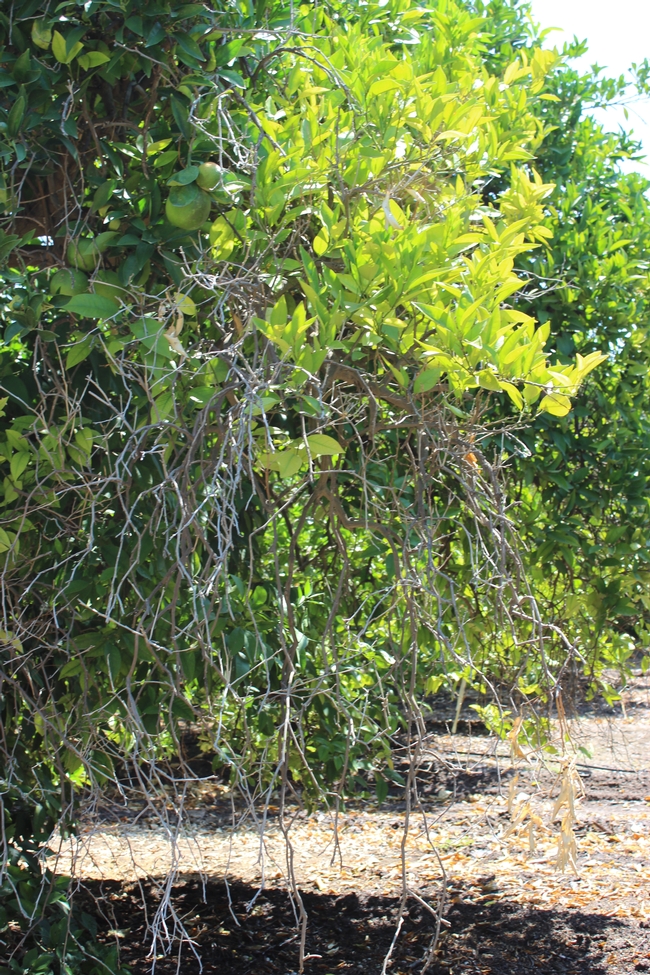
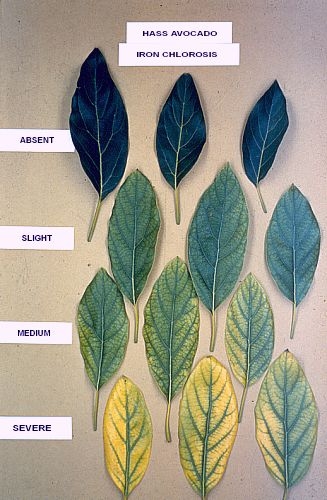
- Author: Ben Faber
Avocado harvest time and the growers are in the orchard checking things out a little more closely and to see what is going into the bins…..and they see some unusual shaped fruit. Here's what's been popping up and some possible explanations.
Crick-side - First described by Dr. J. Eliot Coit as kink-neck and later by Horne (1931) as kink-side. Finally, the name crick-side (Horne, 1934) was adopted. It is characterized by a definite depression on one side between the stem end and the larger portion of the fruit causing a distortion. In some cases, the area of depression turns black and the fruit drops. In other cases, the fruit grows and matures but the distortion remains. Crick-side is usually found on trees carrying a heavy load of fruit. It has been suggested that high temperatures or temporary water-stress may relate to the occurrence of crick-side, but no definite determination as to its cause has been made.
Carapace Spot - First described by Horne (1929), the name carapace-spot was chosen because of the resemblance to a turtles' back. This external blemish is corky and usually cracked into somewhat regular, angular divisions. The flesh under the carapace spot is undamaged, but exterior appearance is such that the fruit is reduced in grade. Slight rubbing or brushing of tender young fruit on leaves or stems appears to cause this corky growth to start. Fruit on trees exposed to strong winds are more apt to develop the trouble. Windbreaks should reduce injury in windy areas.
Photo: Avocado thrips damage, carapace damage and greenhouse thrips damage.
Sunblotch - This is a viroid that can affect fruit, leaves, and stems with a yellow or reddish streaking, cause a compacted growth and willowy growth habit. The streaking in the fruit is usually depressed and doesn't extend the length of the body.
Sunburn - Fruit exposed to full sun may be injured by sunburn. This occurs when trees defoliate, or partially defoliate, from any of several causes, leaving the fruit exposed. It is normally most severe on fruit on the south and southwest portion of the tree. Sunburn shows as a pale yellowish area on the exposed side of the fruit. Often the center of this area turns brown to black and may wither.
Ring Neck - This trouble has been observed occasionally, particularly with Hass. The cause is unknown but is believed to be related to soil-plant water deficiency at a critical time. A ring of tissue on the pedicel just above the attachment to the fruit dies, turns black and peels off. If only superficial, the fruit remains on the tree. Growth may be retarded because the restriction impedes movement of nutrients and water outward to the fruit. Most severe in humid coastal areas.
Embossment - Occasionally, and particularly on Fuertes, a section of the surface will be raised slightly or be a darker or lighter color. This is referred to as a sectional chimera or genetic mutation.
Healed over damage - if fruit has mild damage that allows it to heal over (remember avocado fruit expand by cell multiplication not enlargement), then a scar is left, such as this likely amorbia feeding
Cuke - As in cucumber but not a squash. These are seedless fruit that can most often be seen from a fruit set in cooler weather or due to some hormonal stimulus. We don't know the reason, but seems to occur more commonly along the coast.
Double Fruit - In some instances there may be a normal shaped fruit with a single cuke attached ot in some cases there is a double ovary and two fruit are attached.
Woody Avocados - For some unknown reason, avocado fruit will form into a grotesque woody structure hardly resembling an avocado. The cause is genetic and non-transmissible.
Sources: R.G. Platt - California Avocado Society Yearbook 1972-73 and Reuben Hofshi and M.L. Arpaia Yearbook 2002.
- Author: Ben Faber
USDA Specialty Crops, the Agricultural Marketing News Service and What's Worth Planting
The AMS Specialty Crops Program helps buyers and sellers of all sizes in the U.S. produce industry to market their perishable products in the most efficient manner. They partner with State agencies and other industry organizations for the benefit of nationwide growers, shippers, brokers, receivers, processors, retailers and restaurants, direct to consumer sales, and the foodservice industry.
The program offers a wide array of services that span from helping market the quality of products to ensuring that there is fair trade in the produce industry. The program also helps specialty crops growers and handlers to combine their resources to help their respective industries overcome marketing barriers.
This is also a great website for trolling for potential alternative crops – what is selling, where, for how much and whether it might be a good idea to plant that crop. Check it out:
Main page of AMS:
https://www.ams.usda.gov/market-news/fruits-vegetables
Choose from different fruits:
https://www.marketnews.usda.gov/mnp/fv-nav-byCom?navClass=FRUITS&navType=byComm
For avocados you can see what the various prices are in different markets and times:
If you are interested in coffee prices, it's still considered a "commodity" and a California grown coffee will not be listed:
https://www.fas.usda.gov/data/search?f[0]=field_commodities:609
The USDA Specialty Crops Program also has a food safety certification program that might be of help to growers. In April 2016, the Specialty Crops Program's Specialty Crops Inspection Division (SCI) launched GroupGAP, a new food safety certification program that is part of our USDA Good Agricultural Practices (GAP) suite of services. Our voluntary USDA GAP programs help verify that produce growers and handlers have taken measures to reduce the risk of contamination. Commercial buyers look for USDA GAP-certified suppliers to source safe specialty products. While larger operations can devote the resources needed to become GAP certified, some smaller entities cannot. Until now. GroupGAP allows farmers, food hubs, and marketing organizations of all sizes to band together and pool resources to achieve USDA GAP certification.



